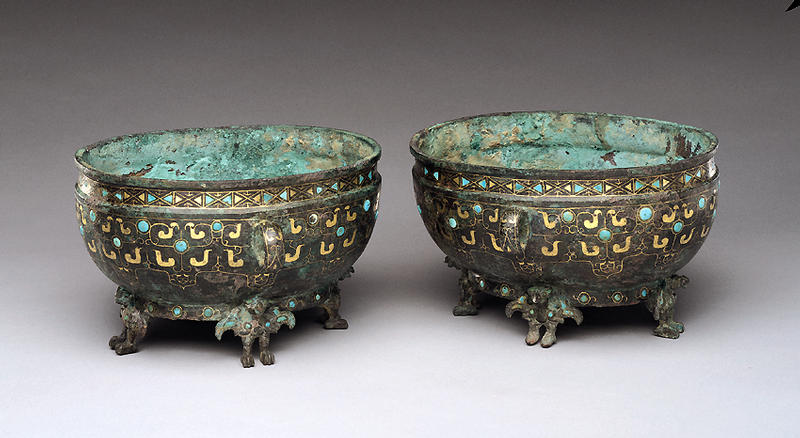楕円形鉢 舟
- 中国
- 中国・東周時代
- 前5-前4世紀
- 青銅、トルコ石、金
- H-10.4 D-17
これは青銅の胎に金、トルコ石の象嵌が引き立つ美麗な器である。器表面の意匠は山西太原金勝大墓から出土した春秋晩期の青銅器に見られる蟠ち文に近似し、口縁に施された矩形と三角形の組み合わせは戦国漆器に見られる一つの特徴でもあるが、貴石象嵌用の穴を含めてどちらも山西侯馬の陶範に酷似した意匠を見出すことができる。 一方でこの器には大変稀有な鳥型の四脚がつけられている。このあらかじめ存在する型の器の圏足に、横に翼を立てて広げた鳥を象った脚を取りつける同時代の類例は、江蘇省漣水三里?をはじめ南部の青銅器や漆器に見られる。これは鷹のような猛禽の類と考えられる。
Catalogue Entry
Drinking cups were key elements of court and religious rituals where wine figured prominently. It is possible that these two nearly identical bowls once served this function. Their shape is unique to the Eastern Zhou period, and it may have developed from drinking cups in other materials.1 However, similarly shaped vessels with lids might have had other functions (compare cat. no. 86).2
These bowls' pattern of fine lines accented by comma shapes--inlaid with gold foil and wire--anchored by round turquoise circlets is refreshingly simple. Although similar gold-inlaid designs appear on other fifth-century vessels and fittings, none exploits the contrasting colors of gold and turquoise as boldly as the one on these vessels.3 The ring handle without gold inlay on one of the bowls is a recent restoration.
The four birds cast separately and soldered on the foot ring of each bowl are most unusual. Because of their frontal pose with spread wings, the strong beaks and talons, and the bright turquoise accents on the wings, they have been compared with predatory birds that are often identified with seminomadic peoples who lived north and west of China's borders.4 Similar birds carved in wood as harness ornaments, excavated from a sixth to fifth century B.C. nomadic tomb at Bashadar in southern Siberia, may be distant prototypes/ancestors.5
Both the distinctive gold-inlaid designs and birds with pronounced beaks and talons can also be associated with bronzes or decorated clay molds from Houma Niucun, Shanxi province.6 Throughout the sixth and fifth centuries B.C., trade between the workshops in Houma and the tribes living beyond their northern frontiers encouraged the borrowing of northern decorative ideas and motifs,7 which might have inspired the bird-shaped legs of these two bowls. But in crossing the frontier, the fierce northern predators were replaced instead by images of elegant creatures with exotic plumage. Fanciful birds supporting an inlaid bronze hu vessel and the mount of a jade cong from a second-century B.C. tomb in Lianshui, Jiangsu province, indicate the longevity of this motif.8
JFS
1. Mackenzie 1991, p. 7; So 1995, no. 53.
2. See So 1995, nos. 58-61.
3. Ibid., pp. 46-47.
4. Mackenzie 1991, p. 8; Tokyo National Museum 1981, nos. 4, 25.
5. Zavitukhina and Barkova 1978, no. 64.
6. Kelley and Ch'en 1946, pls. 44-46; Shanxi sheng 1993, pls. 189-92; So 1995, p. 43.
7. So 1995, chap. 4.3; Bagley 1996.
8. Kaogu 1973.2, pl. 9.1; p. 82, fig. 3.2.
